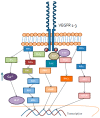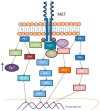Targeting Tyrosine kinases in Renal Cell Carcinoma: "New Bullets against Old Guys"
- PMID: 30999623
- PMCID: PMC6515337
- DOI: 10.3390/ijms20081901
Targeting Tyrosine kinases in Renal Cell Carcinoma: "New Bullets against Old Guys"
Abstract
Clear cell renal cell carcinoma (ccRCC) is the seventh most frequently diagnosed tumor in adults in Europe and represents approximately 2.5% of cancer deaths. The molecular biology underlying renal cell carcinoma (RCC) development and progression has been a key milestone in the management of this type of tumor. The discovery of Von Hippel Lindau (VHL) gene alterations that arouse in 50% of ccRCC patients, leads the identification of an intracellular accumulation of HIF and, consequently an increase of VEGFR expression. This change in cell biology represents a new paradigm in the treatment of metastatic renal cancer by targeting angiogenesis. Currently, there are multiple therapeutic drugs available for advanced disease, including therapies against VEGFR with successful results in patients´ survival. Other tyrosine kinases' pathways, including PDGFR, Axl or MET have emerged as key signaling pathways involved in RCC biology. Indeed, promising new drugs targeting those tyrosine kinases have exhibited outstanding efficacy. In this review we aim to present an overview of the central role of these tyrosine kinases' activities in relevant biological processes for kidney cancer and their usefulness in RCC targeted therapy development. In the immunotherapy era, angiogenesis is still an "old guy" that the medical community is trying to fight using "new bullets".
Keywords: Axl; Fibroblast Growth factor Receptor (FGFR); Kidney cancer; Platelet Derived Growth Factor Receptor (PDGFR); Tyrosine kinase; Tyrosine-Protein Kinase Met (MET); Vascular endothelial growth factor receptor (VEGFR).
Conflict of interest statement
The author declares no conflict of interest. Enrique Grande: Pfizer, Bristol-Myers Squibb, Ipsen, Roche, Eisai, Eusa Pharma, MerckSharp&Dohme, Sanofi-Genzyme, Adacap, Novartis, PierreFabre, Lexicon, Celgene (C/A, SAB), Pfizer, AstraZeneca, MTEM/Threshold, Roche, Ipsen, Lexicon (RF). Pilar Garrido: Roche, MerckSharp&Dohme, MerckSharp&Dohme, Boerhinger Ingelheim, Pfizer, Abbvie, Guardant Health, Novartis, Lilly, Astra-Zeneca, Jansen, Sysmex, Blueprint Medicines, Takeda, Rovi (C/A, SAB). Guardant Health, Sysmex (RF). Alfredo Carrato: The author declares no conflict of interest. Javier Molina-Cerrillo: The author declares no conflict of interest. (C/A): Consulting/Advisory relationship; (RF) Research Funding; (SAB) Scientific Advisory Board.
Figures


Similar articles
-
MicroRNAs Associated with Von Hippel-Lindau Pathway in Renal Cell Carcinoma: A Comprehensive Review.Int J Mol Sci. 2017 Nov 22;18(11):2495. doi: 10.3390/ijms18112495. Int J Mol Sci. 2017. PMID: 29165391 Free PMC article. Review.
-
Sunitinib, sorafenib and mTOR inhibitors in renal cancer.J BUON. 2007 Sep;12 Suppl 1:S151-62. J BUON. 2007. PMID: 17935273 Review.
-
Oncotargets in different renal cancer subtypes.Curr Drug Targets. 2015;16(2):125-35. doi: 10.2174/1389450116666150126110632. Curr Drug Targets. 2015. PMID: 25619751 Review.
-
Tubulocystic renal cell carcinoma: is there a rational reason for targeted therapy using angiogenic inhibition? Analysis of seven cases.Virchows Arch. 2013 Feb;462(2):183-92. doi: 10.1007/s00428-012-1367-z. Epub 2013 Jan 8. Virchows Arch. 2013. PMID: 23296808
-
Understanding the importance of smart drugs in renal cell carcinoma.Eur Urol. 2006 Apr;49(4):633-43. doi: 10.1016/j.eururo.2006.01.016. Epub 2006 Feb 2. Eur Urol. 2006. PMID: 16481093 Review.
Cited by
-
Role of tyrosine kinases in bladder cancer progression: an overview.Cell Commun Signal. 2020 Aug 14;18(1):127. doi: 10.1186/s12964-020-00625-7. Cell Commun Signal. 2020. PMID: 32795296 Free PMC article. Review.
-
Molecular Characterization, Tumor Microenvironment Association, and Drug Susceptibility of DNA Methylation-Driven Genes in Renal Cell Carcinoma.Front Cell Dev Biol. 2022 Mar 21;10:837919. doi: 10.3389/fcell.2022.837919. eCollection 2022. Front Cell Dev Biol. 2022. PMID: 35386197 Free PMC article.
-
New Therapeutic Interventions for Kidney Carcinoma: Looking to the Future.Cancers (Basel). 2022 Jul 25;14(15):3616. doi: 10.3390/cancers14153616. Cancers (Basel). 2022. PMID: 35892875 Free PMC article. Review.
-
MMPs, tyrosine kinase signaling and extracellular matrix proteolysis in kidney cancer.Urol Oncol. 2021 Jun;39(6):316-321. doi: 10.1016/j.urolonc.2020.04.034. Epub 2020 May 31. Urol Oncol. 2021. PMID: 32487351 Free PMC article. Review.
-
Hyperprogression to a dual immune blockade followed by subsequent response with cabozantinib in metastatic poor-risk clear cell renal cell carcinoma with NOTCH mutation.Oncotarget. 2020 Jun 2;11(22):2137-2140. doi: 10.18632/oncotarget.27598. eCollection 2020 Jun 2. Oncotarget. 2020. PMID: 32547710 Free PMC article.
References
Publication types
MeSH terms
Substances
LinkOut - more resources
Full Text Sources
Other Literature Sources
Medical
Research Materials
Miscellaneous

